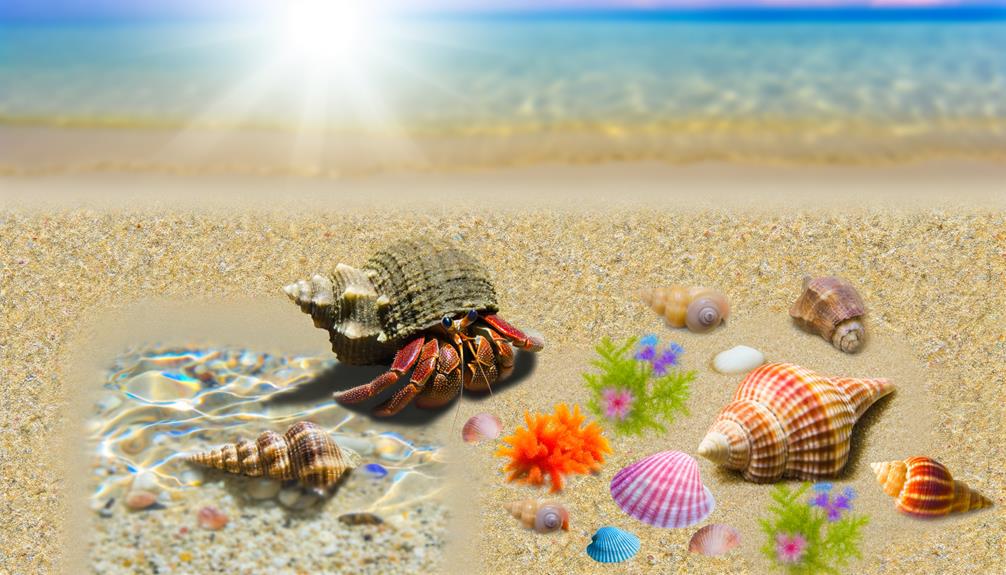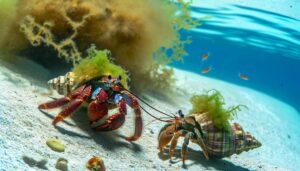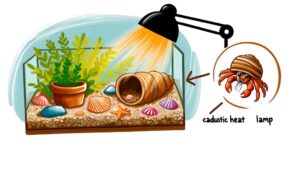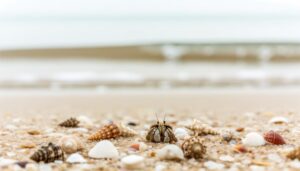Do Hermit Crabs Need Water for Essential Hydration?
Hermit crabs need access to both freshwater and saltwater. Hydration is crucial for their metabolic processes, molting, and respiration.
You should provide dechlorinated freshwater and marine-grade saltwater to prevent dehydration and maintain proper humidity. Their antennae help them locate water, which they scoop to drink.
Regular bathing in these waters also aids their health. Make sure their water dishes allow for easy access while maintaining correct salinity levels.
Improper hydration can be fatal, so monitor water quality and avoid untreated tap water. Balanced hydration is vital for their longevity and well-being.
Learn detailed care practices for healthier hermit crabs.

Key Takeaways
- Hermit crabs need access to both freshwater and saltwater for drinking and bathing.
- Proper hydration is essential for their health, molting, and metabolic processes.
- Regular bathing in water helps hermit crabs maintain hydration and overall well-being.
- Ensure water is dechlorinated and saltwater is mixed with marine-grade salt.
- Monitor salinity, water quality, and humidity levels to prevent dehydration and respiratory issues.
Importance of Water
Water plays a vital role in the physiological processes of hermit crabs, influencing their hydration, molting, and overall health. Without proper hydration, hermit crabs can suffer from dehydration, impairing their cellular functions. Research shows that water is essential during the molting process, as it helps them expand their exoskeletons to shift into new shells.
Additionally, water facilitates efficient metabolic processes, ensuring they absorb nutrients effectively. By maintaining ideal humidity levels, you'll also prevent respiratory issues, as their modified gills require moisture to function correctly. Ensuring your hermit crabs have access to clean, appropriate water sources directly impacts their survival and well-being, making it a key aspect of their care.
Freshwater Needs
You need to make sure that hermit crabs have access to clean drinking water sources to maintain peak hydration levels. Research indicates that frequent water changes and using dechlorinated water can greatly enhance their health.
Additionally, monitoring hydration maintenance tips will help you create a more stable environment for your hermit crabs.
Drinking Water Sources
Ensuring hermit crabs have access to clean, dechlorinated freshwater is critical for maintaining their osmoregulation and overall health. You should provide a shallow dish of dechlorinated water, ensuring it's easily accessible.
Chlorine and chloramines in tap water can be harmful, so use a water conditioner specifically designed for marine life. Hermit crabs absorb moisture through their gills and drink from these water sources to regulate their internal salt balance. Research shows that improper hydration can lead to fatal complications.
Frequent monitoring and changing of the water are essential to prevent bacterial growth and contamination, ensuring your hermit crabs remain healthy. Proper freshwater availability directly impacts their physiological and behavioral well-being, supporting their natural hydration processes.
Hydration Maintenance Tips
To maintain optimal hydration levels in hermit crabs, it's important to regularly provide them with clean, dechlorinated freshwater in shallow dishes. Research indicates that hermit crabs utilize freshwater for both drinking and shell hydration, essential for their osmoregulation and overall health.
Make sure the dish is shallow enough to prevent drowning but deep enough for the crabs to submerge their bodies partially. Use dechlorinating agents or allow tap water to sit for 24 hours to evaporate chlorine. Regularly monitor water quality, as contaminants or imbalances can stress or harm the crabs.
Water Changing Frequency
Regularly changing the freshwater in hermit crab enclosures is crucial for maintaining ideal hydration and preventing the accumulation of harmful contaminants. You should replace the freshwater daily, as this guarantees the removal of debris, feces, and uneaten food.
A consistent water-changing schedule reduces the risk of bacterial growth, which can compromise the hermit crabs' health. Use dechlorinated water to prevent chlorine toxicity, which can be fatal. Monitoring water quality with test kits helps ensure the absence of ammonia, nitrites, and nitrates.
Saltwater Requirements
Hermit crabs require a consistent supply of saltwater to maintain their osmotic balance and overall health. You should prepare saltwater using a marine-grade salt mix, ensuring the specific gravity is between 1.021 and 1.026. This range closely mimics their natural habitat.
Regularly test the water's salinity and pH levels to prevent fluctuations that could stress the crabs. Inadequate saltwater can lead to dehydration and impaired molting processes. Moreover, make sure the saltwater is free from contaminants such as chlorine and heavy metals, which can be harmful.
Drinking Habits
Understanding hermit crabs' drinking habits is important for maintaining their hydration and health. Hermit crabs need both freshwater and saltwater for optimal hydration.
You should provide two separate, shallow dishes: one with dechlorinated freshwater and another with marine-grade saltwater. Hermit crabs use their antennae to locate water sources, and they drink by scooping water into their mouths with their claws.
Monitoring water levels daily will help you ensure they've consistent access. Research indicates that providing water at varying depths can cater to different sizes of hermit crabs, promoting inclusive access.
Bathing Rituals
You should evaluate the frequency of baths to ensure best health, usually suggesting immersion in saltwater once a week.
Use proper bathing techniques, such as maintaining appropriate water depth to prevent drowning and using dechlorinated water to avoid harmful chemicals.
Research indicates that these measures noticeably decrease the risk of bacterial infections and stress in hermit crabs.
Frequency of Baths
Regular bathing routines are necessary for hermit crabs to maintain their overall health and hydration. Studies indicate that hermit crabs should be bathed approximately once a week. This frequency ensures they can adequately absorb moisture through their gills, which is vital for respiration.
Additionally, regular baths help to remove any debris or contaminants that might accumulate on their exoskeleton. By providing consistent bathing intervals, you can prevent potential health issues such as molting complications and dehydration.
Monitoring their hydration status and adjusting the frequency based on environmental conditions, such as humidity levels, can further optimize their well-being. Implementing these practices demonstrates a commitment to their care, fostering a thriving environment for your hermit crabs.
Proper Bathing Techniques
To guarantee hermit crabs receive the full benefits of their weekly baths, it's essential to follow proper bathing techniques that cater specifically to their physiological needs. Research indicates that maintaining ideal water temperature, salinity, and duration is vital for their health. Use dechlorinated water at a temperature between 72-78°F to prevent thermal shock. Ensure the bath lasts no longer than 20 minutes to avoid stress.
| Parameter | Ideal Range | Purpose |
|---|---|---|
| Water Temperature | 72-78°F | Prevent thermal shock |
| Salinity Level | 1.020-1.023 SG | Mimic natural habitat conditions |
| Bath Duration | 10-20 minutes | Minimize stress |
Humidity Levels
Maintaining proper humidity levels, typically between 70% and 80%, is essential for the respiratory health and overall well-being of hermit crabs. Hermit crabs possess modified gills, which require a humid environment to facilitate efficient gas exchange. Without adequate humidity, their gills can dry out, leading to respiratory distress and potential fatality.
Utilize a hygrometer to monitor humidity levels within the enclosure consistently. Implementing a substrate mix of sand and coconut fiber can help retain moisture. Additionally, misting the habitat regularly and providing a water dish can elevate humidity. Ensuring ideal humidity not only supports respiratory function but also aids in molting, a critical process for growth and exoskeleton maintenance.
Your meticulous care directly impacts their survival and thriving.
Proper Hydration
Securing proper hydration is essential for hermit crabs, as they depend on both fresh and saltwater sources to support necessary physiological processes. Freshwater is important for internal hydration and cellular function, while saltwater is needed for osmoregulation and shell maintenance. Research indicates that hermit crabs display a dual hydration mechanism, requiring constant access to both water types.
You should monitor water quality, as contaminants can result in health issues. Maintaining clean water with appropriate salinity levels ensures best hydration. Regularly changing the water and using a dechlorinator for freshwater can prevent harmful buildup of toxins.
Balancing these hydration requirements will support the hermit crab's overall well-being, promoting longevity and health.
Water Dish Setup
Setting up the water dish for hermit crabs involves making sure it's shallow enough to prevent drowning but deep enough to allow for effective hydration and shell maintenance. Ideal dish depth ranges from 0.5 to 1 inch, accommodating both small and larger crabs.
Utilize non-porous materials like ceramic or glass to prevent bacteria buildup. The dish's surface should be textured, enabling crabs to climb out easily, reducing the risk of entrapment. Include a small sponge or pebbles in the dish to provide additional grip and prevent accidental drowning.
Regularly monitor and replace water to maintain cleanliness. Your careful attention to these details ensures the well-being and longevity of your hermit crabs, reflecting your dedication to their care.
Water Quality
For peak health, hermit crabs require water quality that mimics their natural habitat, necessitating careful attention to factors such as salinity, pH levels, and contaminants.
You'll need to maintain a salinity level of 1.021 to 1.024 specific gravity for marine hermit crabs, using marine salt mix. Freshwater should be dechlorinated; use a water conditioner to remove harmful chlorine and chloramines.
Monitor the pH, aiming for a neutral range of 7.5 to 8.5 for optimum conditions. Regularly test for ammonia, nitrites, and nitrates, as these contaminants can be lethal even in small concentrations.
Consistent water changes, utilizing pre-mixed and tested water, guarantee the environment remains stable, promoting your hermit crabs' well-being and longevity.
Common Mistakes
Neglecting to regularly test and adjust water parameters is a common mistake that can significantly impact the health of your hermit crabs. Inconsistent salinity, pH levels, or contamination can lead to stress and health issues. Ensuring the correct balance is essential for their well-being.
| Common Mistake | Consequence | Solution |
|---|---|---|
| Failing to test water parameters | Health deterioration | Regularly test and adjust water quality |
| Using untreated tap water | Chemical exposure | Use dechlorinated or conditioned water |
| Incorrect salinity levels | Osmoregulatory stress | Maintain appropriate salinity (1.021-1.028) |
| Ignoring water temperature | Metabolic imbalances | Keep water temperature between 75-82°F |
Monitoring Hydration
How can you accurately monitor the hydration levels of your hermit crabs to guarantee their peak health and well-being?
First, measure the salinity of their saltwater pool using a refractometer; aim for 1.021-1.026 specific gravity.
Regularly check the freshwater pool for evaporation, making sure it's always available.
Observe their behavior: lethargy or excessive burrowing may indicate dehydration.
Maintain relative humidity between 70%-80% using a hygrometer, as proper humidity is essential for their gill function.
Use a digital thermometer to confirm the temperature stays between 75°F and 85°F, as improper temperature affects water retention.
Record these parameters daily in a log to identify trends.
Consistent monitoring guarantees your hermit crabs remain hydrated and healthy.
Conclusion
You've learned that hermit crabs require both freshwater and saltwater to thrive.
Surprisingly, did you know that a hermit crab can drink up to 10% of its body weight in water daily?
This necessity emphasizes the importance of maintaining proper hydration and water quality.
By meticulously setting up water dishes and monitoring hydration levels, you'll guarantee your hermit crabs stay healthy and vibrant.
Remember, small details like water quality can make a significant difference in their overall wellbeing.






